Motivation and Emotion | Quizlet
1/71
There's no tags or description
Looks like no tags are added yet.
Name | Mastery | Learn | Test | Matching | Spaced |
|---|
No study sessions yet.
72 Terms
motivation
process that directs + energizes behavior, also called 'goal-directed behavior'
instinct
- a biological theory of motivation
-inborn patterns of behavior,
- biologically determined rather than learned -> essential for survival
-an inherited characteristic that automatically produces a particular response
fixed action pattern
a behavior that once it started will always be finished, mostly in animals, part of instinct
supernormal stimulus
a stimulus whose features have been artificially enhanced or exaggerated, it causes the same response (instead of an egg a larger red ball)
problems with instinct
- no agreement on how many instincts there are (some said 14.000+)
- doesn't explain the why of a pattern of behavior
- variety/comlexity of human and animal behavior, cannot be explained only as instinctive
drive-reduction theory of motivation
A physiological need, or drive, compels us to reduce that need
• When people lack some basic biological need (e.g., water), a drive to obtain that requirement is generated (e.g., thirst)
• People are always trying to reduce internal tension
Hull: B = D x H
Behaviour is the result of drive and habit
• Drive is bigger the longer someone is deprived of the need
• Habit forms when behaviour is reinforced (operant conditioning)
problems with drive-reduction theory
- does not account for how secondary reinforcers impact drive, for ex. money
- doesn't explain people that engage in behavior that does not reduce a drive (e.g., eating when not hungry)
or even in activities that increase
tension such as skydiving.
optimal arousal theory of motivation
-argues that the level of stimulation in the environment influences brain arousal, which in turn influences behavior (in terms of approach or avoidance
-the belief that we try to maintain certain levels of stimulation and activity
- reduce or increase stimulation when excitement is too high or low
- people have different levels of optimal excitement/activity
Yerkes-Dodson Law (arousal approaches)
-performance increases with arousal only up to a point, beyond which performance decreases
- it depends on how difficult a certain task is, the more difficult the less stimuli surrounding you you can take (distraction)
-Relation between performance and
arousal also depends on
nature/difficulty of the task
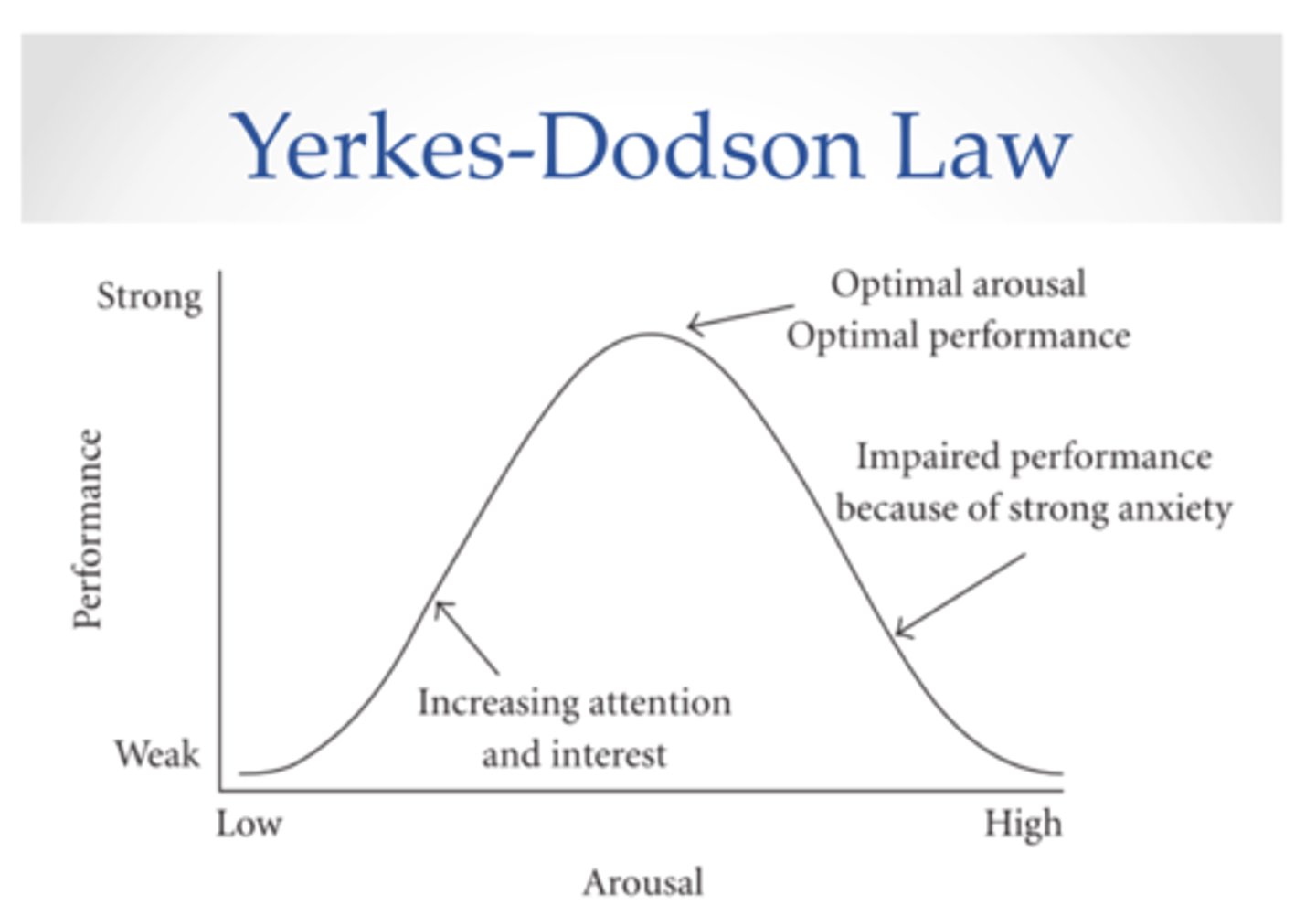
incentive approach
environmental stimuli that pull organism to a goal
- stresses external factors, ex. food that looks appetizing
social cognitive theories of motivation
- expectancy and value theory: goal directed behavior is jointly determined by the strength of the persons expectations that particular behaviors will lead to a gaol and by the incentive value the individual places on that goal
motivation= expectancy x incentive value
ex: Eleanor works hard because she believes (expectancy) that the more she studies, the more likely she is to get an A (incentive), and she values an A highly.
-incentives
intrinsic vs. extrinsic motives
- instrinsic: performing an activity for its own sake, for ex: because you enjoy the activity
- extinsic: performing something to receive an external reward or avoid punishment
overjustification effect
- negative effect of extrinsic motivation
- expected external motivation such as prize may decrease intrinsic motivation. The person may now see the reward, rather than intrinsic interest, as the motivation for performing the task.
Maslow's Hierarchy of Needs
- saw striving for personal growth as a key motivation
- first basic needs must be met before higher needs can be tackled
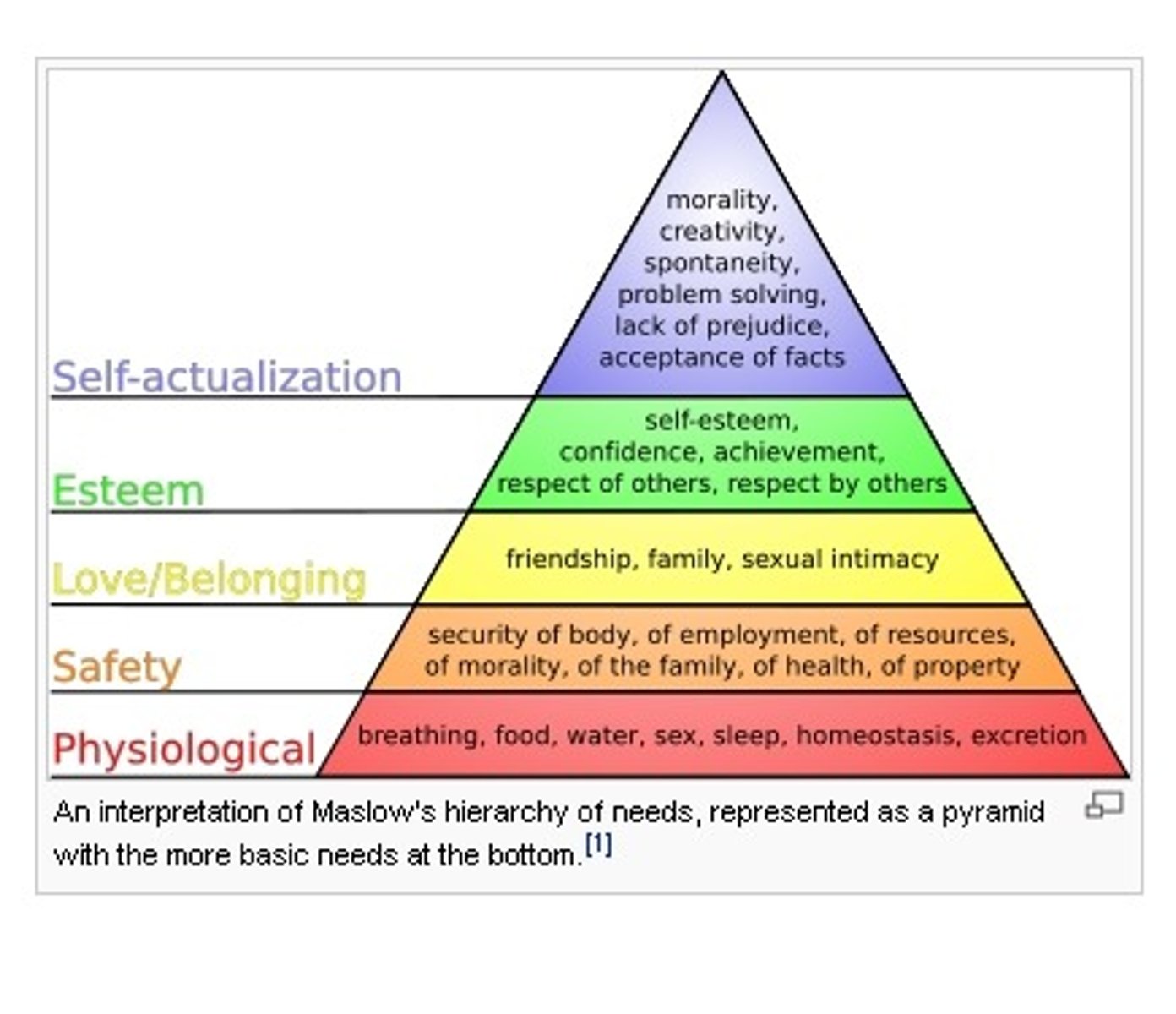
achievement motivation
- motive for success and fear failure
- achievement goal theory
-mastery approach: wanting to complete a task for the purpose of self improvement and learning as much as possible
-mastery avoidance: wanting to avoid a task because they feel they wont learn as much as they need order to complete the task
-performance approach: the desire to complete a task to outperform a peer group, achieve the appearance of superiority, and receive an extrinsic reward
-performance avoidance: the desire to avoid the task to evade embarrassment, self doubt, shame, or public failure
-
achievement goal theory
mastery orientation (personal improvement)
ego orientation (outperform others)
motivational conflicts
approach-approach: when we face two attractive alternatives and selecting one means loosing the other
ex: choice between two interesting courses:
avoidance-avoidance: when we must choose between two undesirable alternatives
ex: keep studying for less interesting course or fail
approach-avoidance: being attracted to and repelled by the same goal
ex: interested in choosing a very different course, but afraid to fail
function of emotion
Preparing us for action
• A link between events in our environment and our responses
• Shaping our future behaviour
• Act as reinforcement (either to stop or experience the
emotion)
• Helping us to interact more effectively with others
• Act as a signal to observers, allowing them to better
understand what we are experiencing and to predict our future behaviour
drives
states of internal tension that motivate an organism to behave in ways that reduce this tension
learned helplessness
learning that unpleasant stimuli cannot be avoided or controlled
BAS (behavioral activation system)
-regulates approach motivation
-one of two distinct neural systems in the brain
-roused to action by signals of potential reward and positive need gratification
-activity in this system causes the person to begin or to increase movement towards positive goals in anticipation of pleasure
-produces emotions of hope, elation, and happiness
reward relevant input- stimulates BAS- resulting in desire anticipation of pleasure, approach behavior
BIS (behavioral inhibition system)
-underpins avoidance motivation
-one of two distinct neural systems in the brain
-responds to stimuli that signal potential pain, non-reinforcement and punishment
-produces fear, inhibition of behavior (such as when we freeze in terror), as well as escape and avoidance behaviors
punishment relevant input- stimulates BIS- resulting in aversion, anticipation of pain, fear, depression, avoidance, and inhibition
approach and avoidance theories of motivation
-trys to take greater account of the role of a persons content and environment
-optimal arousal (Hebb)
- based on these tendencies: motivation impels us towards some things and away from others is compatible with the idea that we seek to maximize pleasure and minimize pain, gravitate towards rewards, and avoid punishment
^ reflect the activity of two distinct neural systems the BAS and BIS
psychodynamic theory
Freudian theory "dual instinct model" that unconscious forces can motivate their behavior
self actualization
according to Maslow, one of the ultimate psychological needs that arises after basic physical and psychological needs are met and self-esteem is achieved; the motivation to fulfill one's potential
self-transcendence
according to Maslow, the striving for identity, meaning, and purpose beyond the self, committing to the welfare of others
self determination theory
focuses on three fundamental psychological needs: competence, autonomy, and relatedness
-ppl are most fulfilled in their lives when they are able to satisfy these fundamental needs
need for competence
reflects a human desire to master new challenges and to perfect skills
need for autonomy
represents the motivation to achieve greater freedom and regulation by the self, rather than by external forces
need for relatedness
refers to the self's desire to form meaningful bonds with others
positive psychology
the scientific study of optimal human functioning; aims to discover and promote strengths and virtues that enable individuals and communities to thrive
flow
the state of total involvement in an activity that requires optimal concentration
metabolism
the body's rate of energy or caloric utilization
set point
a biologically determined standard around which body weight (or fat mass) is regulated
when you eat, digestive enzymes break down food into key nutrients such as ______
glucose and fatty acids
-glucose is a simple sugar that is the body and brains major source of immediately usable fuel
-fatty acids result from the breakdown of fat, these can be stored to supply energy to the body when needed
Cholecytokinin (CCK)
a peptide that helps produce satiety
leptin
A hormone produced by adipose (fat) cells that acts as a satiety factor in regulating appetite.
Achievement Goal Theory
A theory of motivation stating that when the person is motivated to achieve a goal, certain goals (mastery goals) produce better outcomes than other goals (performance goals).
high need achievers
strong motive for success and relitively low fear of failure, tend to seek moderately difficult tasks that are challenging but attainable
low need achievers
more likely to choose easy tasks where success is assured, or very difficult tasks where success is not expected
what are the three basic achievement goals?
mastery: associated with viewing achievement tasks as a positive challenge
ego approach: most strongly linked to eventual course grades for college students
ego avoidance: linked to viewing such tasks as threatening
emotion
feeling that impact behavior, both physiological + cognitive elements - strong adaptive function
difference between mood and emotion
Emotions are short-lived feelings that come from a known cause, while moods are feelings that are longer lasting than emotions and have no clear starting point of formation.
categorical model of emotion
- all emotions are derived from a set of innate universal emotions- basic emotion model
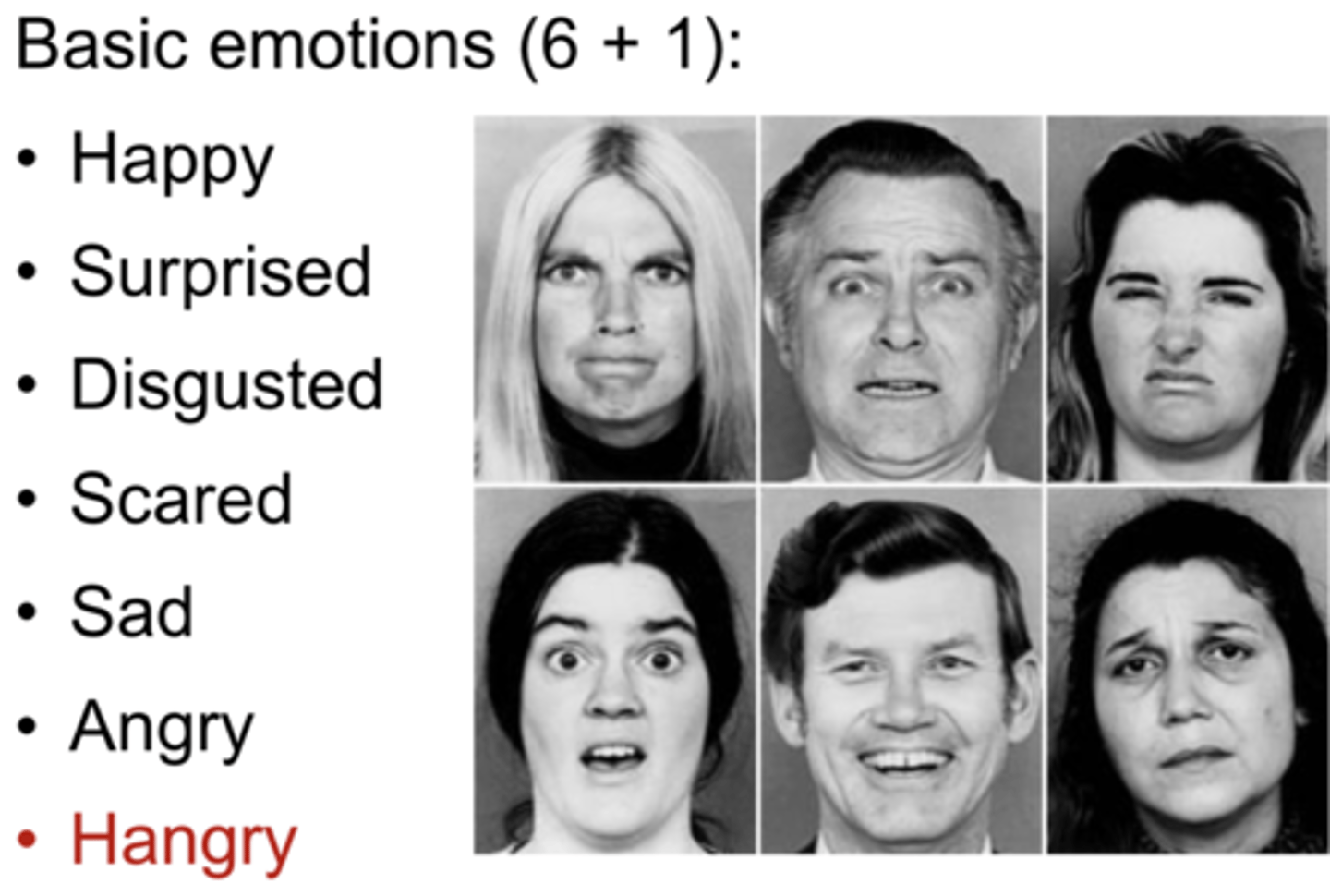
dimensional approach
- emotions are not discrete but result from activity on two dimensions:- arousal and valence- circumflex model
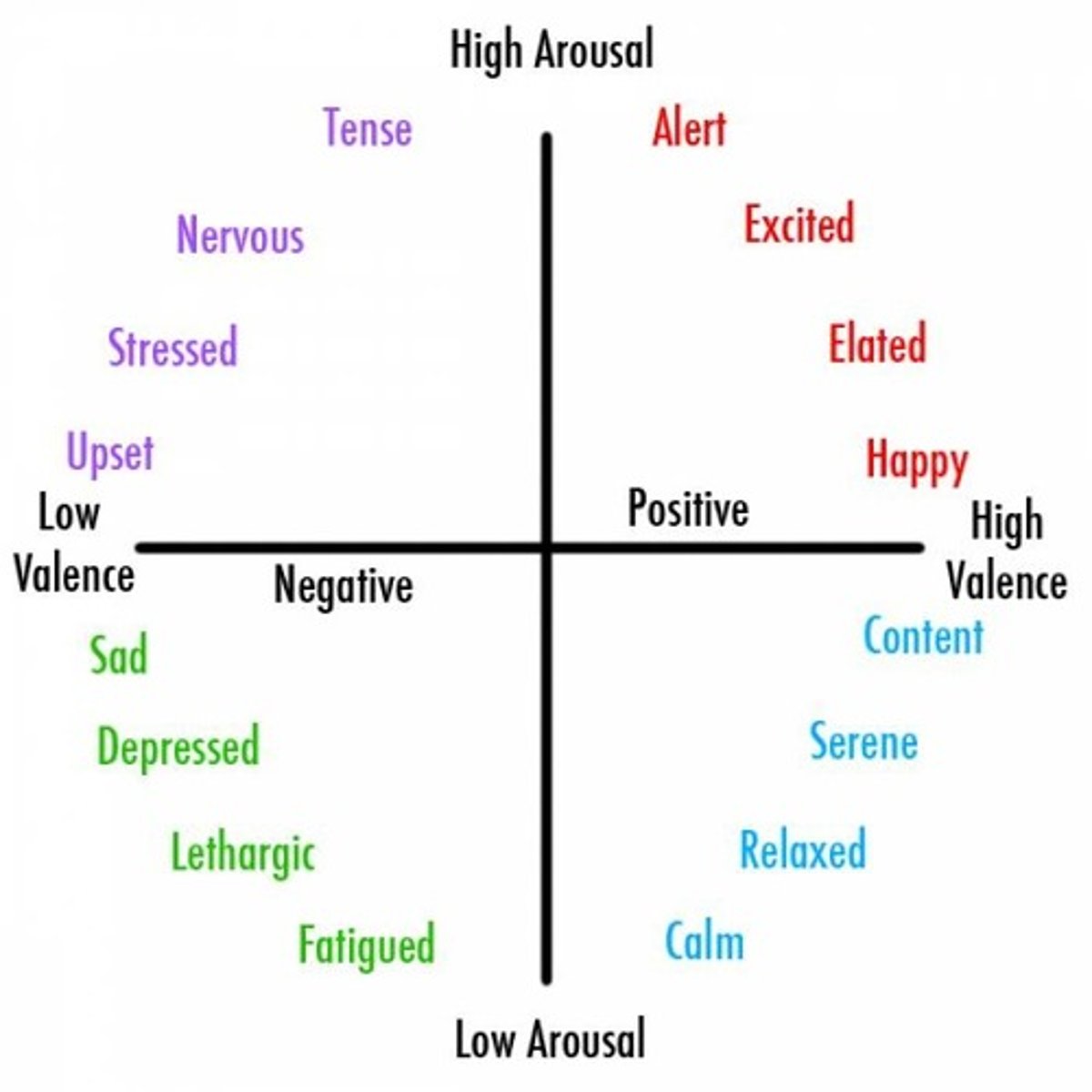
hybrid approaches: plutchik
8 basic emotions in a ring, the more to the outside you go the more complex they get (kinda like a color wheel)
-8 basic emotions
trust, fear, surprise, sadness, disgust, anger,
anticipation, joy
Each with a long evolutionary history
• e.g. trust facilitates tribal sharing /
collaboration
• e.g. fear leads to flight from danger
All emotions are variants of these
• e.g. joy + trust = love
• e.g. sadness + anger = envy
Emotions have polar opposites
• e.g. trust vs. disgust
• e.g. surprise vs. anticipation

common sense theory
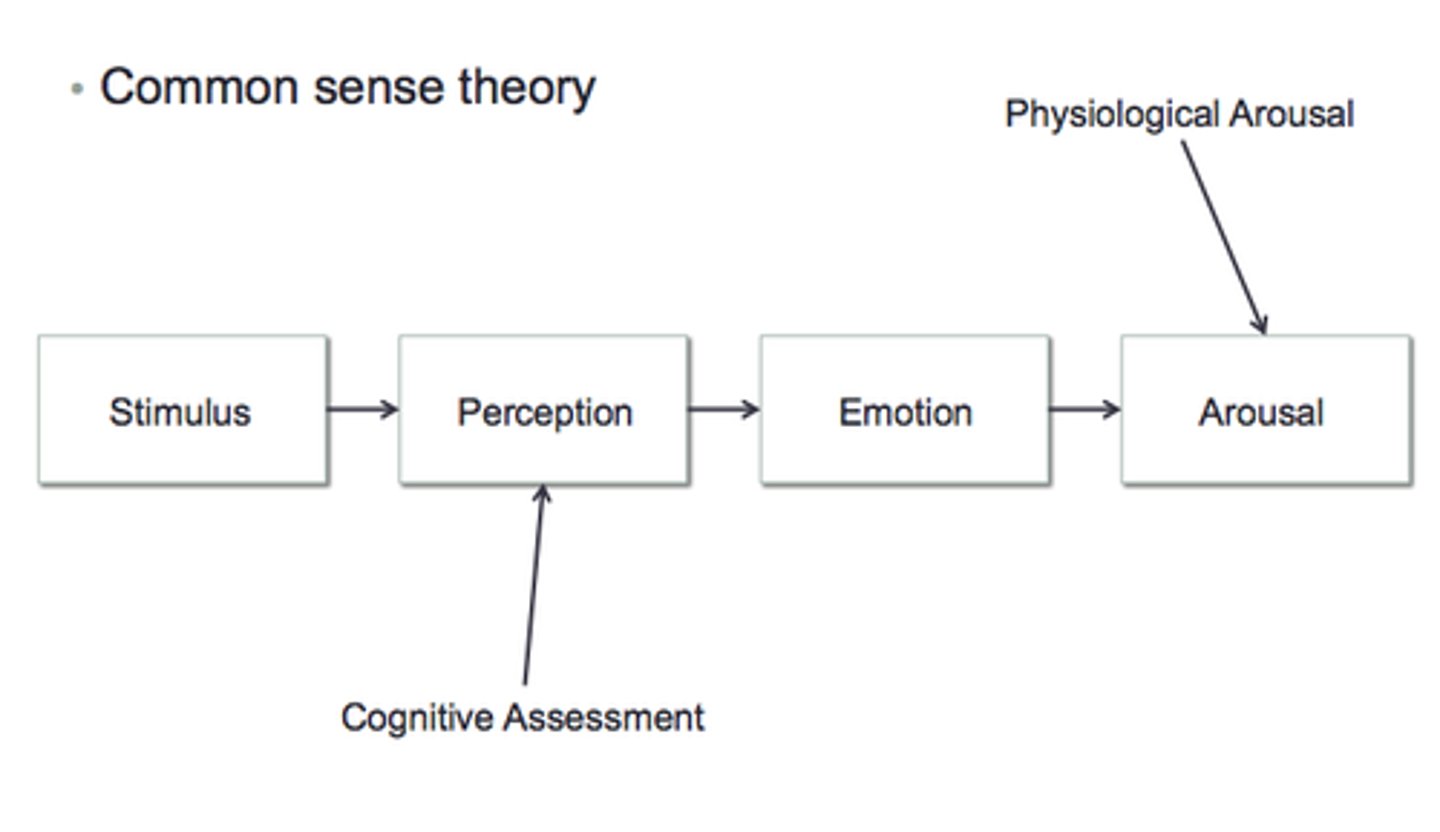
James-Lange Theory
stimulus -> perception -> bodily arousal -> emotion
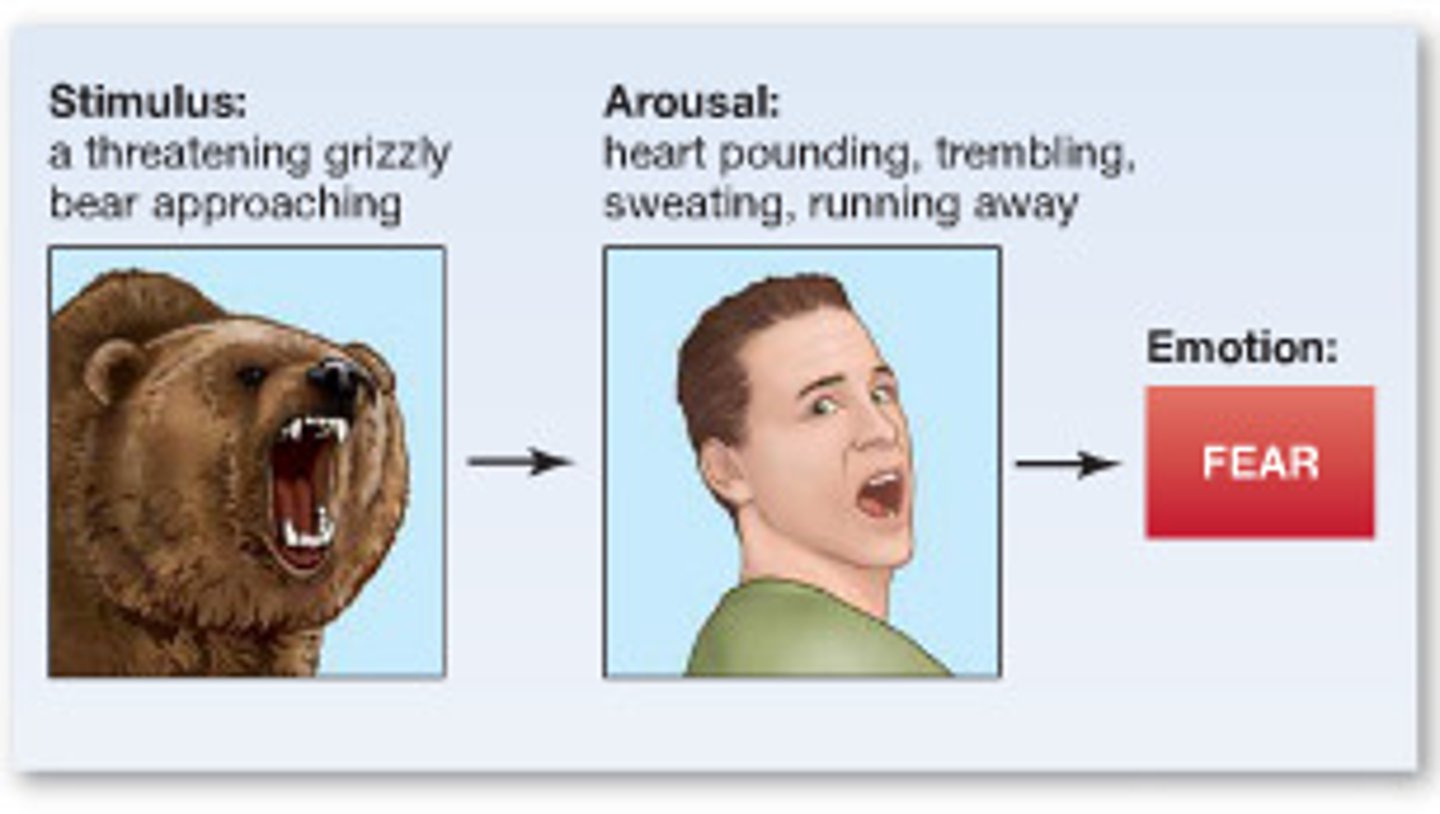
challanges to James-Lange theory
- Timing - it takes too long
• Not distinctive
• Similar visceral responses different emotions
• Physiological arousal does not invariably emotion
• Adrenaline injections no change, or 'as-if' emotional experience
• Severed afferent nerves from sympathetic NS emotions present
Two separate paths (physiological / experiential)
Proposed that emotional stimuli are processed in the brain, which then separately generates bodily responses and feelings
Canon-Bard theory
stimulus -> thalamus -> emotion + bodily arousal
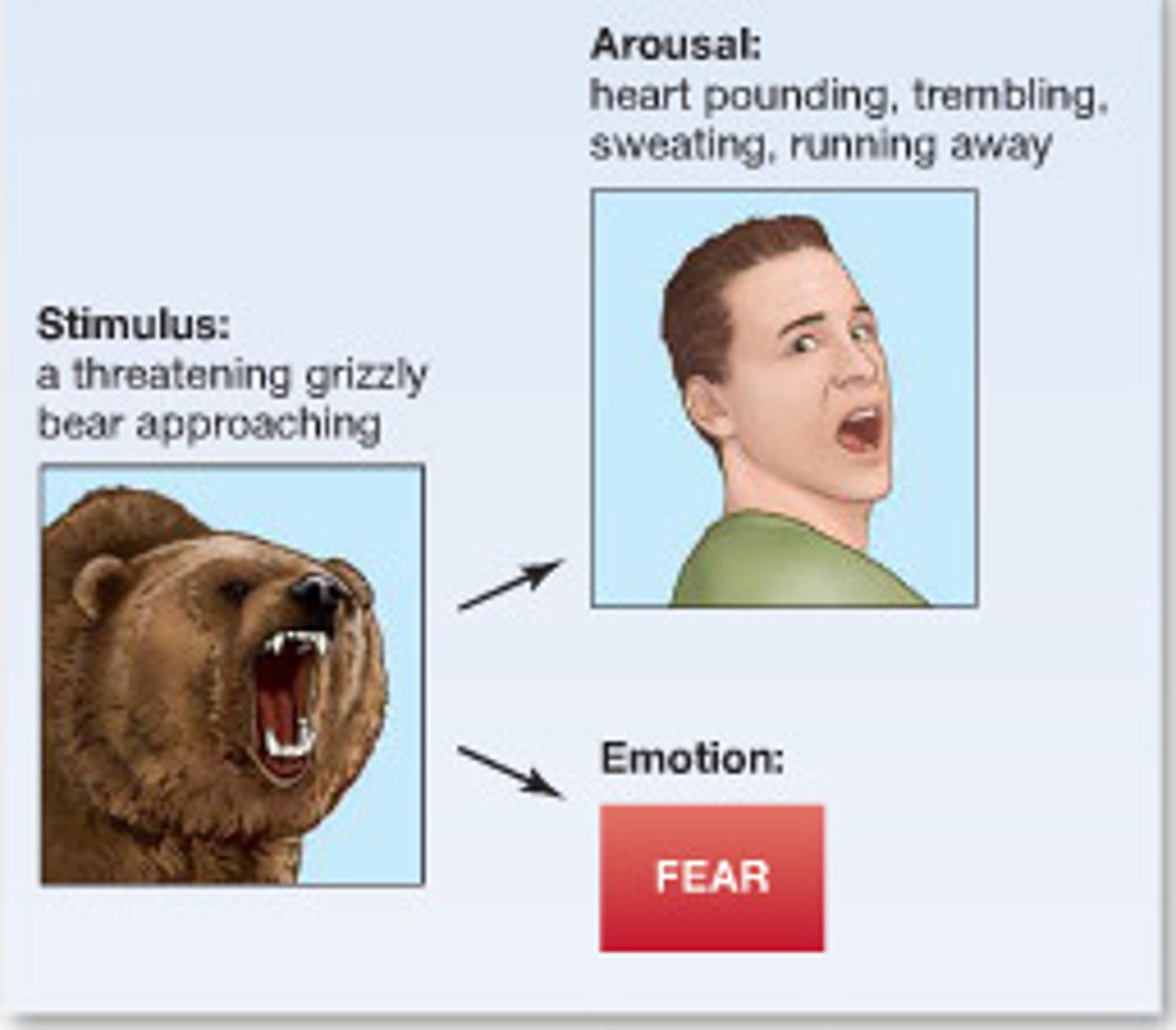
The skaky bridge theory
hetero men walked across a bridge, some a shaky bridge some a safe bridge- they saw an attractive male/female- more people called when they walked the shaky bridge because---- Misattribution of arousal, they thought they were aroused by the person but it was actually the bridge
Schachter-Singer theory
stimulis -> perception -> bodily arousal (pounding heart)/cognitive appraisal (I'm afraid)-> emotion- the intensity of arousel determines degree of emotion- cognitive assessment determines type of emotion
-Emotion depends on the interpretation of arousal in the context of situational cues (i.e., a person's judgments about why their physiology
has changed)
Predictions:
• When you KNOW why you feel aroused your emotional state won't change
• When you DON'T KNOW why you feel aroused, you will attribute the "feeling" to a change in emotion
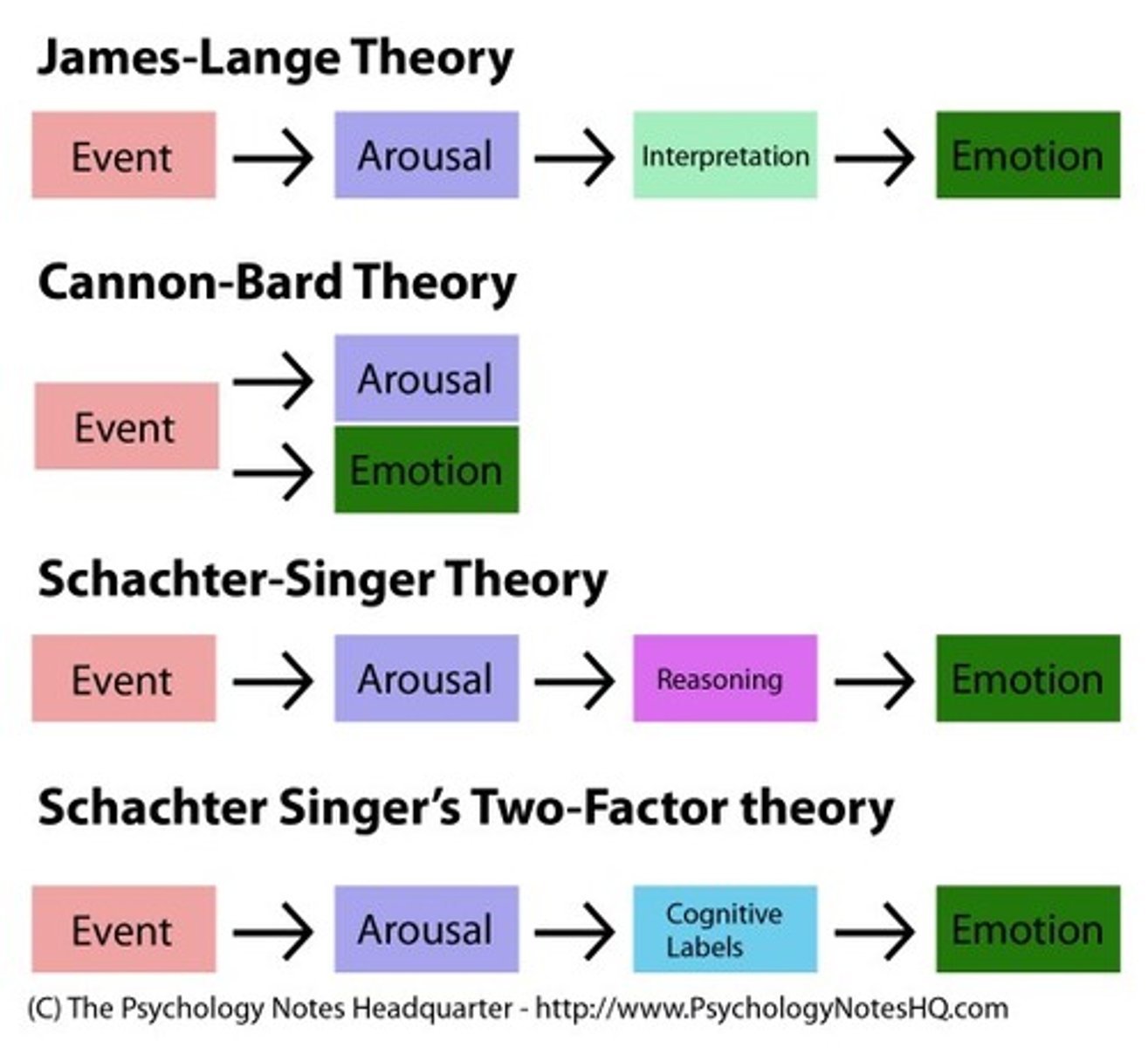
loss aversion
the strong tendency to regard
losses as considerably more important than
gains of comparable magnitude
-Studied in the context of Prospect Theory
(Kahneman & Tversky, 1979)
• Daniel Kahneman received the Nobel Prize for
this work
prospect theory framing effect
gain context: A. get 75 euro
B. 50% chance to get to euro and 50% chance to get 100 euro
(ppl are more likely to choose option A)
loss context: A.loose 75 euro
B.50% chance to lose 50 euro and 50% chance to lose 100
(most people would choose B)
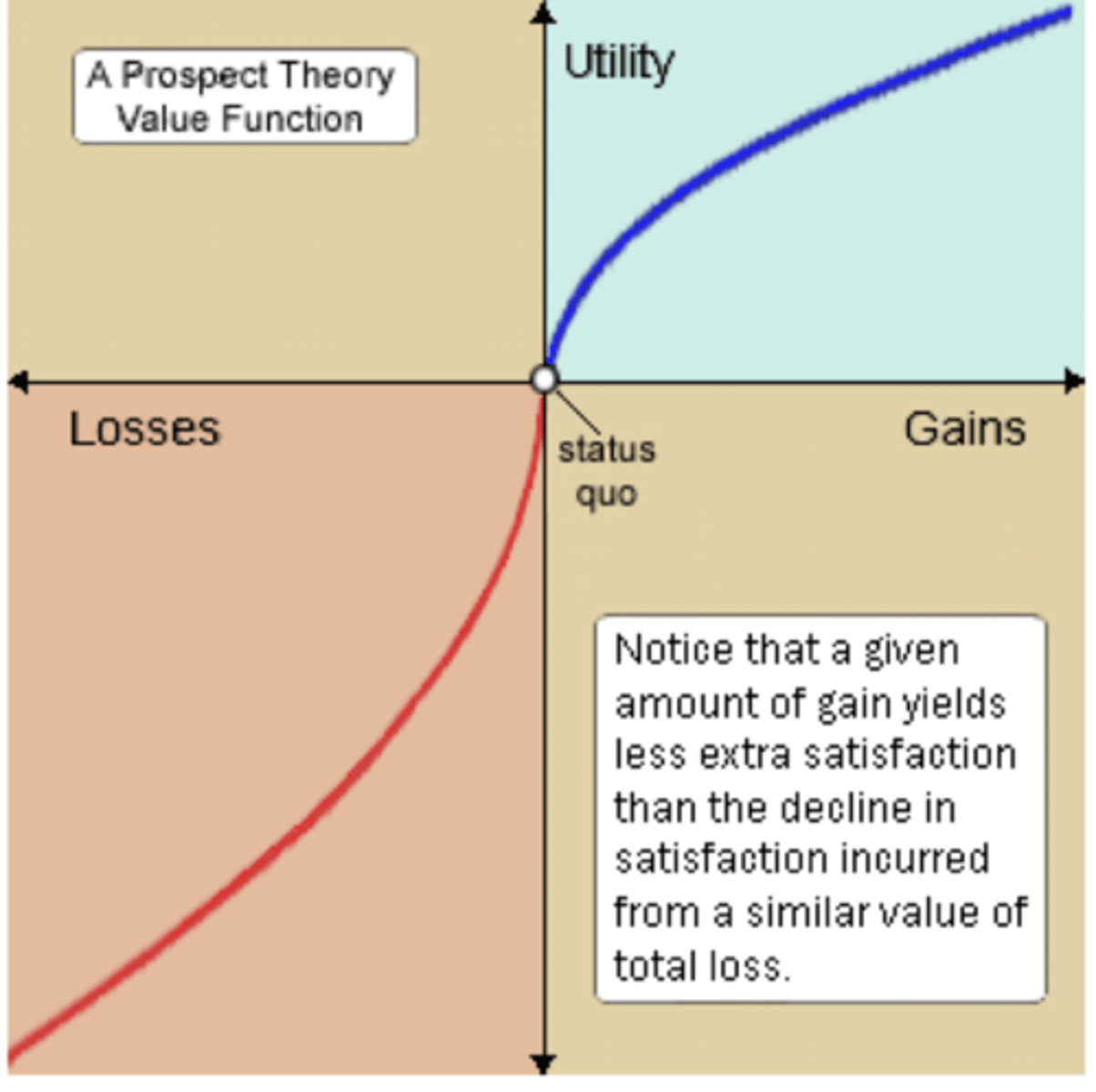
problem/difficulties with incentive approach
Organisms seek to fulfil needs when incentives are absent
• Drive approach and Incentive approach may work together in
motivating behaviour ("Push" and "pull" factors)
• We seek to satisfy underlying hunger (push of drive-reduction
theory)
• AND we are drawn to food that appears particularly appetizing
(pull of incentive theory)
example of over justification effect
Lepper and colleagues' magic marker studies
• Method: Some children given rewards for using magic
markers
• Results: Those children later showed less enthusiasm for
drawing
-> Rewards can undermine intrinsic interest
organize the approaches of motivation into biological, psychosocial, and biopsychosocial approaches
Biological Approaches=
Instinct: People and animals are born with preprogrammed sets of behaviours essential to their survival.
Drive Reduction: When some basic biological requirement is lacking a drive is produced.
Arousal: People seek an optimal level of stimulation. If the level of stimulation is too high, they act to reduce it; If it is too low, they act to increase it.
Psychosocial Approaches=
Incentive: External stimuli direct and energize behaviour
Cognitive: Thoughts, expectations and understanding of the world direct motivation.
Biopsychosocial Approaches=
Maslow's Hierarchy of Needs: Needs form a hierarchy; before higher-order needs are
met, lower-order needs must be fulfilled.
predicting from schachter; how we know what we feel?
Our experience of emotion
depends on 2 factors:
general arousal and a cognitive label
• We may interpret our arousal
as fear or excitement,
depending on the context
schater and singer experiment
Method
• Injection
• Epinephrine (higher heart and respiration rate)
IVs
• Informed vs. ignorant
• Angry vs. euphoric confederate
DV
• Participants' emotional reaction to confederate's
behavior
Same physiological response different attribution
-results: "describe your emotional state"= labeling of arousal based on environment
I tremble because I feel afraid of
this alligator
common sense theory
I feel afraid of this alligator
because I tremble
James Lange theory
This alligator makes me tremble
and feel afraid
cannon-bard theory
I label my trembling as fear
because I appraise the alligator
as dangerous
Schachter-Singer Theory
sensation patterns for different emotions
-some emotions have either an increase or decrease in sensations
cognitive appraisals
Personal interpretations and meanings that we attach to sensory stimuli
fundamental emotional patterns
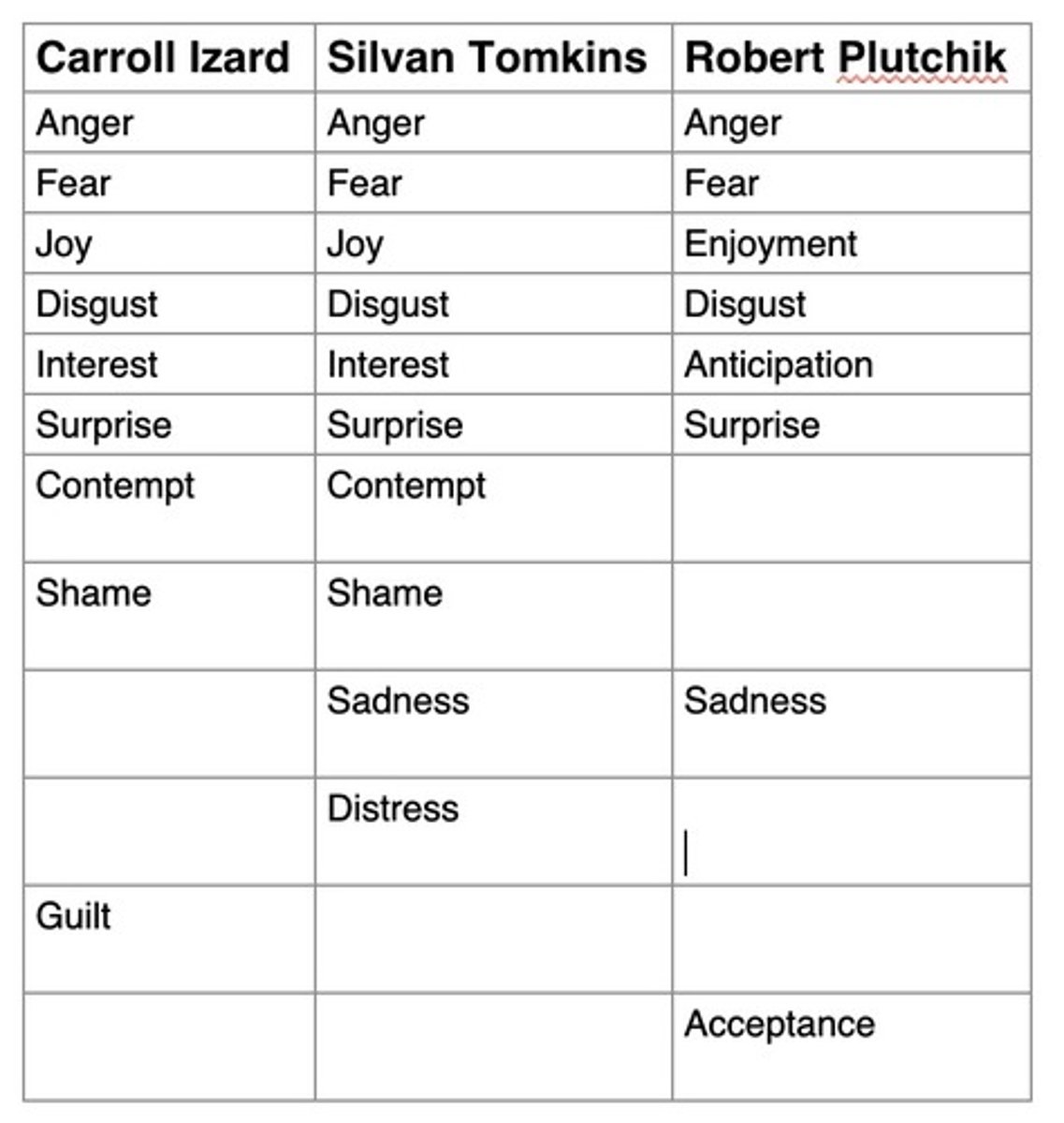
instrumental behaviors
directed at achieving some emotion-relevant goal
ex: highly anxious student must find some way to cope with an impending task
where are our physiological responses in emotion produced
hypothalamus, the limbic system, the cortex, and the autonomic and endocrine systems
-there appear to be two systems for emotional behavior, one involving conscious processesing by the cortex, and the other unconscious by the amygdala
negative vs positive emotions in the hemispheres
negative emotions seem to reflect greater activation of the right hemisphere
-positive emotions are related relitivelky greater activation in the left hemisphere
why has the validity of the polygraph as a lie detector been questioned?
the difficulty of establishing the meaning of recorded physiological responses
facial feedback hypothesis
the idea that facial expressions can influence emotions as well as reflect them
-feedback from facial muscles to the brain plays a key role in determining the nature and intensity of emotions that we experience
mere exposure effect
the tendency for liking to increase with the frequency of exposure
Downward vs upward social comparison
downward: seeing ourselves as better off than the standard for comparison
upward comparison: when we view ourselves as worse off than the standard for comparison